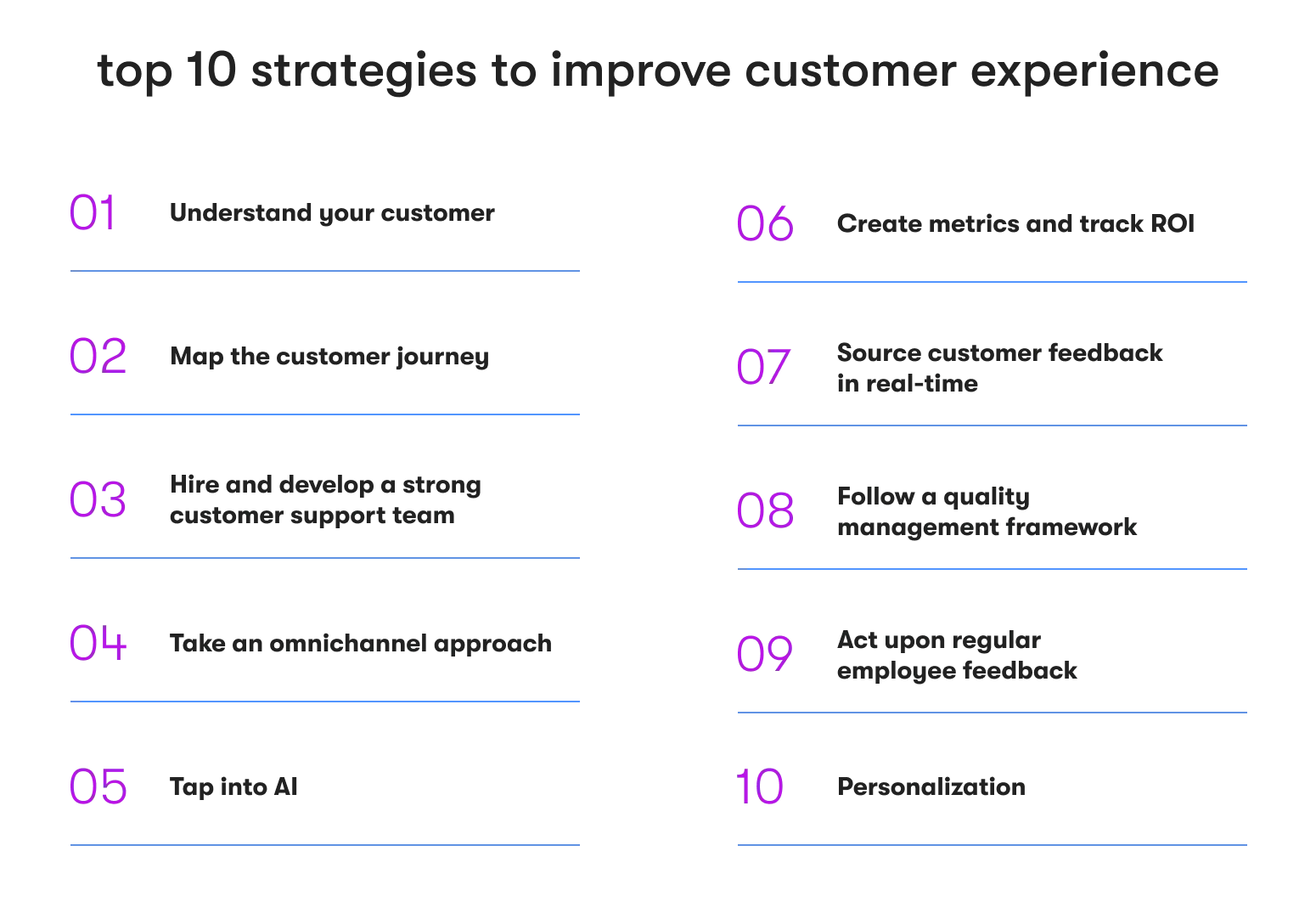Customer experience is the cornerstone of success in ecommerce. As businesses strive to differentiate themselves in a crowded marketplace, mastering the art of delivering exceptional customer experience becomes paramount. This comprehensive guide explores the essence of ecommerce customer experience management and unveils ten actionable strategies to elevate your brand's customer experience game.
In addition to mastering the art of delivering exceptional customer experiences, businesses must prioritize continuous improvement and adaptation in response to evolving consumer expectations and market dynamics. This involves embracing innovation, leveraging emerging technologies, and staying attuned to industry trends and best practices. By fostering a culture of innovation and agility, businesses can remain responsive to changing customer needs and preferences, ensuring that their ecommerce customer experience strategies remain relevant and practical. With a commitment to ongoing improvement and a willingness to embrace change, businesses can position themselves for long-term success in the ever-evolving ecommerce landscape.
What is customer experience?
The customer experience (CX) is more than just a transaction — it's an emotional journey that shapes how your customers interact with your brand. In ecommerce, where digital touchpoints dominate, customer experience extends beyond the virtual storefront to encompass every online interaction and engagement.
At its core, customer experience encapsulates the entirety of a customer's journey — from the moment they land on your website or mobile app to the final click of the purchase button and beyond. It encompasses the ease of navigation, the relevance of product recommendations, the responsiveness of customer support, and the overall sense of satisfaction derived from the entire customer journey.
Customer experience is about creating meaningful connections with happy customers and fostering positive emotions at every touchpoint. It's about understanding customers' needs, anticipating their preferences, and delivering solutions that meet and exceed their expectations.
In the dynamic landscape of ecommerce, where competition is fierce and options are abundant, customer experience emerges as the key differentiator. A seamless, more personalized experience and memorable CX can turn casual browsers into loyal advocates, driving repeat purchases and business growth.
To excel in ecommerce customer experience, businesses must prioritize empathy, innovation, and continuous improvement. By putting the customer's perspective at the center of every decision and leveraging technology to enhance their journey, brands can create transformative experiences that resonate long after the transaction.
Customer experience vs. customer service
In ecommerce, "customer experience" and "customer service" are often used interchangeably, but they represent distinct facets of the customer journey.
Customer service typically refers to the specific interactions and assistance provided to customers when they encounter issues or have inquiries. It encompasses responding to emails, addressing product concerns and the customer's problems, and resolving complaints.
On the other hand, customer experience is a broader concept encompassing a customer's journey with a brand — from initial awareness to post-purchase engagement. It includes every interaction, touchpoint, and impression that shapes the customer's perception and overall satisfaction.
While customer service focuses on reactive problem-solving, customer experience takes a proactive approach through designing web solutions for ecommerce and managing every aspect of the customer journey to evoke positive emotions and build lasting relationships.
Customer service is a subset of customer experience. It's an essential component but not the entire picture. A seamless customer experience goes beyond resolving issues promptly; it involves anticipating needs, delivering personalized solutions, and creating memorable moments that delight customers at every turn.
In the competitive ecommerce landscape, where customer expectations constantly evolve, businesses must prioritize customer service and customer experience to stay ahead. By offering exceptional service and crafting transformative experiences, brands can exceed customer expectations, cultivate loyalty, drive satisfaction, and ultimately thrive in the digital marketplace.
CREATE EXCEPTIONAL EXPERIENCES FOR YOUR CUSTOMERS
With our expert teams, you can elevate your customer experience and set your brand apart in a competitive landscape.
Why is customer experience important?
In the competitive ecommerce landscape, where countless options are just a click away, superior customer experience is the linchpin of success. Exceptional ecommerce customer experience isn't just a nice-to-have — it's a strategic imperative that can spell the difference between thriving businesses and those struggling to stay afloat.
At its core, an excellent customer service experience is more than just transactions; it's about emotions, perceptions, and customers' overall journey when interacting with a brand. In the digital realm, where virtual touchpoints replace face-to-face interactions, the excellent customer service experience quality becomes even more critical.
Exceptional customer experience is the cornerstone of customer satisfaction, fostering loyalty and driving repeat purchases. When customers feel valued, understood, and appreciated, they're more likely to return to your ecommerce platform, recommend it to others, and become brand advocates.
Moreover, prioritizing positive customer experience here isn't just about keeping customers happy — it's also about boosting business outcomes. Satisfied customers are more likely to spend more, increasing revenue and customer lifetime value. They're also less likely to churn, reducing customer acquisition costs and enhancing profitability.
In essence, customer experience is the foundation of successful ecommerce businesses. By delivering memorable, seamless, personalized experiences, brands can differentiate themselves in a crowded marketplace, foster long-term customer relationships, and drive sustainable growth.
4 factors affecting customer experience
Delivering exceptional customer experiences is essential for retaining a loyal customer base. However, achieving this goal has its challenges.
Various factors can hinder the effectiveness of the ecommerce customer experience, presenting obstacles that businesses must navigate to succeed in the digital marketplace. These challenges can impact customer satisfaction, loyalty, and business success, from long response times to customer inquiries and failure to understand customer needs to lack of human touch and personalization.
Overcoming these hurdles requires a strategic approach integrating technology, human touch, personalization, and a deep understanding of customer needs. By addressing these factors proactively, businesses can enhance their ecommerce customer experience, build stronger relationships with their target audience, and ultimately drive sustainable success in the digital marketplace.
- Long response times: In the fast-paced world of ecommerce, delayed responses to customer inquiries or complaints can lead to frustration and erode trust. Customers expect prompt and efficient assistance, and any delay in addressing their concerns can result in a negative experience.
- Not understanding customer needs: To deliver exceptional customer experiences, businesses must have a deep understanding of their customers' preferences, pain points, and expectations. Grasp these insights to avoid irrelevant or misaligned interactions with customer needs.
- Lack of human touch: While automation can streamline processes and improve efficiency, it shouldn't come at the expense of human connection. Over-reliance on automated systems and methods can alienate customers who crave personalized, human interactions. Balancing automation with human touchpoints is essential for fostering meaningful relationships with customers.
- Lack of personalization: In today's hyper-personalized world, customers expect tailored experiences that resonate with their preferences and interests. Generic communication and one-size-fits-all product offerings must engage customers personally, leading to disengagement and reduced loyalty.
10 strategies to improve ecommerce customer experience
Enhancing the ecommerce customer experience is a multifaceted endeavor that requires a strategic approach and careful execution. By implementing the following ten strategies, businesses can elevate their customer experience game, foster long-term customer loyalty, and drive sustainable growth.

Understand your customer
Thorough market research and data analysis are paramount to understanding your target audience's needs, preferences, and behavior. By delving deep into customer demographics, psychographics, and purchase patterns, businesses can tailor their offerings and experiences to align with customer expectations.
Understanding your customers involves more than just demographic data; it requires a comprehensive understanding of their motivations, pain points, and behaviors. Utilize surveys, focus groups, and analytics to gain insights into customers' preferences and expectations. By understanding your customers deeper, you can tailor your products, services, and marketing efforts to better meet their needs.
Map the customer journey
Identifying and optimizing every touchpoint across the customer journey is crucial for ensuring a seamless and delightful experience. From the initial discovery phase to post-purchase support, mapping the customer journey helps businesses anticipate needs, remove friction points, and create memorable interactions at each stage to improve customer experience.
Mapping the customer journey involves identifying all the touchpoints and interactions a customer has with your brand throughout their buying journey. This includes everything from browsing your website or app to contacting customer support and purchasing. By mapping out these touchpoints, you can identify areas where the customer experience can be improved and implement strategies to enhance it.
Hire and develop a strong customer support team
Investing in training and developing a robust customer success team is essential for delivering prompt, empathetic assistance and resolving customer issues more effectively. Empowering frontline staff with the necessary skills and resources enables them to handle customer inquiries professionally and efficiently, enhancing customer success and overall satisfaction.
Your customer support team is often the first point of contact for customers with questions or concerns. Investing in training and development is essential to ensure that your team has the skills and knowledge to provide excellent service. Provide ongoing training to keep your entire team up-to-date on product knowledge, communication skills, and problem-solving techniques. Additionally, empower your team to take ownership of customer issues and empower them to resolve problems quickly and effectively.
EXPLORE YOUR ECOMMERCE POTENTIAL WITH US
Maximize your ecommerce success with our comprehensive ecommerce consulting and engineering services.
Take an omnichannel approach
Ensuring consistency and continuity across multiple channels — website, mobile app, social media, etc. — is key to a unified and cohesive customer experience strategy. By integrating various touchpoints and channels, businesses can offer customers a seamless customer journey map regardless of how they interact with the brand.
Today's customers expect to be able to interact with brands seamlessly across multiple channels. Whether browsing your website on their laptop, using your mobile app on their phone, or engaging with you on social media, they expect a consistent experience. An omnichannel approach ensures customers can seamlessly transition between channels without losing continuity or quality. You can increase customer satisfaction and loyalty by providing a cohesive experience across all channels.
Tap into AI
Leveraging artificial intelligence services opens up opportunities for personalized product recommendations, business automation, chatbots for instant support, and predictive analytics to proactively anticipate and meet customer needs. AI-powered solutions enable businesses to deliver tailored experiences at scale, driving engagement and satisfaction.
Artificial intelligence (AI) can revolutionize ecommerce customer experience by enabling businesses to deliver more personalized and responsive interactions. Chatbots, for example, can provide instant customer support 24/7, answering questions, resolving issues, and providing recommendations. Predictive analytics can analyze customer data to anticipate their needs and preferences, allowing businesses to offer personalized product recommendations and promotions. Companies can provide more efficient and satisfying customer experiences by tapping into AI technologies.
Create metrics and track ROI
Establishing key performance indicators (KPIs) allows businesses to measure the effectiveness of their CX initiatives and track each strategy's return on investment (ROI). By monitoring customer satisfaction scores, retention rates, and average order value metrics, businesses can assess their efforts' impact and identify improvement areas.
Metrics and analytics are crucial in improving ecommerce customer experience by providing insights into customer behavior, preferences, and satisfaction levels. By tracking key metrics such as customer satisfaction scores, Net Promoter Score (NPS), and lifetime value (LTV), businesses can gain valuable insights into their customers' perceptions and experiences. This data can help identify areas for improvement and guide strategic decision-making to enhance the overall customer experience for ecommerce.
Gather customer feedback in real-time
Implementing feedback mechanisms such as customer surveys, reviews, and social listening tools enables businesses to collect honest feedback and address issues promptly. Real-time feedback provides valuable insights into customer preferences, pain points, and satisfaction levels, guiding continuous improvement efforts.
Gathering customer feedback is essential for understanding how customers perceive your brand and identifying areas for improvement. Businesses can collect valuable insights into customer preferences, pain points, and satisfaction levels by implementing feedback mechanisms such as surveys, reviews, and social listening tools. Real-time feedback allows businesses to identify and address issues promptly, improving the overall customer experience.
Follow a quality management framework
Adopting quality management frameworks like Six Sigma or ISO standards ensures consistency, reliability, and continuous improvement in CX processes. By adhering to established quality standards, businesses can maintain high levels of customer satisfaction and drive positive experiences across all touchpoints.
Act upon regular employee feedback
Encouraging and acting upon regular employee feedback fosters positive customer experiences. Frontline staff is often the first point of contact for customers, and their insights and suggestions can provide valuable perspectives on areas for improvement.
Personalization
Tailoring product recommendations, promotions, and communication-based on individual preferences, purchase history, and browsing behavior enables businesses to create meaningful and memorable experiences for each customer. Personalization fosters a sense of emotional connection and relevance, driving engagement and loyalty.
How can we help you?
At EPAM Startups & SMBs, we empower ecommerce businesses to thrive in the digital landscape. From optimizing your ecommerce management to crafting intuitive web designs, we're here to partner with you on your journey to delivering exceptional customer experiences.
Conclusion
Mastering ecommerce to improve your customer experience is not just a goal — it's an ongoing journey of understanding, adapting, and innovating. By prioritizing customer-centric strategies, harnessing the power of technology, and fostering a culture of excellence, you can transform ordinary transactions into extraordinary experiences that delight and retain customers for the long haul.
Embracing customer-centricity principles involves understanding and exceeding customer expectations at every touchpoint. It's about anticipating needs, delivering personalized experiences, and fostering genuine connections that resonate with customers deeply.
By leveraging data-driven insights, businesses can comprehensively understand customer preferences, behaviors, and pain points. With this knowledge, they can optimize the entire customer journey, streamline processes, and create seamless experiences that inspire loyalty and satisfaction.
Furthermore, maintaining a customer-centric culture requires continuous feedback and improvement. By actively soliciting and acting upon customer feedback, businesses can address issues promptly, iterate on their offerings, and stay ahead of evolving customer expectations.
FAQ

Anush has a history of planning and executing digital communications strategies with a focus on technology partnerships, tech buying advice for small companies, and remote team collaboration insights. At EPAM Startups & SMBs, Anush works closely with subject matter experts to share first-hand expertise on making software engineering collaboration a success for all parties involved.
Anush has a history of planning and executing digital communications strategies with a focus on technology partnerships, tech buying advice for small companies, and remote team collaboration insights. At EPAM Startups & SMBs, Anush works closely with subject matter experts to share first-hand expertise on making software engineering collaboration a success for all parties involved.
Explore our Editorial Policy to learn more about our standards for content creation.
read more


















